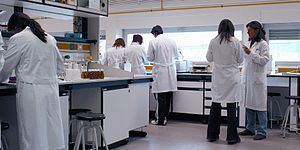Names Scientist | ||
 | ||
Activity sectors Use of scientific method | ||
Coldplay the scientist
A scientist is a person engaging in a systematic activity to acquire knowledge that describes and predicts the natural world. In a more restricted sense, a scientist may refer to an individual who uses the scientific method. The person may be an expert in one or more areas of science. The term scientist was coined by the theologian, philosopher and historian of science William Whewell. This article focuses on the more restricted use of the word. Scientists perform research toward a more comprehensive understanding of nature, including physical, mathematical and social realms.
Contents
- Coldplay the scientist
- Coldplay the scientist lyrics
- Description
- By country
- USA
- By gender
- Historical development and etymology of the term
- Ancient and medieval science
- Historical scientists
- Types of scientists
- By employer
- References

Philosophy is today typically regarded as a distinct activity from science, though the activities were not always distinguished in this fashion, with science considered a "branch" of philosophy rather than opposed to it, prior to modernity. Philosophers aim to provide a comprehensive understanding of fundamental aspects of reality and experience, often pursuing inquiries with conceptual, rather than empirical, methods. Natural scientific research is usually also distinguished from inquiry in the Humanities more generally, and often with inquiry in the Social Sciences and Mathematics on various grounds, although these distinctions may be controversial.

Scientists are also distinct from engineers, those who design, build, and maintain devices for particular situations; however, no engineer attains that title without significant study of science and the scientific method. When science is done with a goal toward practical utility, it is called applied science. An applied scientist may not be designing something in particular, but rather is conducting research with the aim of developing new technologies and practical methods. When science seeks to answer questions about fundamental aspects of reality it is sometimes called natural philosophy, as it was generally known before the 19th century.

Coldplay the scientist lyrics
Description

Science and technology have continually modified human existence through the engineering process. As a profession the scientist of today is widely recognized. Scientists include theoreticians who mainly develop new models to explain existing data and predict new results, and experimentalists who mainly test models by making measurements — though in practice the division between these activities is not clear-cut, and many scientists perform both tasks.

Jurisprudence and mathematics are often grouped with the sciences. Some of the greatest physicists have also been creative mathematicians and lawyers. There is a continuum from the most theoretical to the most empirical scientists with no distinct boundaries. In terms of personality, interests, training and professional activity, there is little difference between applied mathematicians and theoretical physicists.
Scientists can be motivated in several ways. Many have a desire to understand why the world is as we see it and how it came to be. They exhibit a strong curiosity about reality. Other motivations are recognition by their peers and prestige, or the desire to apply scientific knowledge for the benefit of people's health, the nations, the world, nature or industries (academic scientist and industrial scientist). Scientists tend to be less motivated by direct financial reward for their work than other careers. As a result, scientific researchers often accept lower average salaries when compared with many other professions which require a similar amount of training and qualification.
By country
The number of scientists is vastly different from country to country. For instance, there are only 4 full-time scientists per 10,000 workers in India while this number is 79 for the United Kingdom and the United States.
USA
According to the US National Science Foundation 4.7 million people with science degrees worked in the United States in 2015, across all disciplines and employment sectors. The figure included twice as many men as women. Of that total, 17% worked in academia, that is, at universities and undergraduate institutions, and men held 53% of those positions. 5% of scientists worked for the federal government and about 3.5% were self-employed. Of the latter two groups, two-thirds were men. 59% of US scientists were employed in industry or business, and another 6% worked in non-profit positions.
By gender
Scientist and engineering statistics are usually intertwined, but they indicate that women enter the field far less than men, though this gap is narrowing. The number of science and engineering doctorates awarded to women rose from a mere 7 percent in 1970 to 34 percent in 1985 and in engineering alone the numbers of bachelor's degrees awarded to women rose from only 385 in 1975 to more than 11000 in 1985.
This inequality follows into the professional setting in terms of both position and income. According to Eisenhart and Finked, women's experiences, even when they have equal qualifications, are that they start in lower positions while men are granted tenure track positions. This later predicts a gender inequality of tenured positions as scientists in universities, "as of 1989, 65 percent of men and only 40 percent of women held tenured positions." Income conflicts occur when median annual salaries for full-time employed civilian scientists are compared, "salary for men is $48,000, and that for women is $42,000."
Historical development and etymology of the term
Until the late 19th or early 20th century, scientists were called "natural philosophers" or "men of science".
English philosopher and historian of science William Whewell coined the term scientist in 1833, and it first appeared in print in Whewell's anonymous 1834 review of Mary Somerville's On the Connexion of the Physical Sciences published in the Quarterly Review. Whewell's suggestion of the term was partly satirical, a response to changing conceptions of science itself in which natural knowledge was increasingly seen as distinct from other forms of knowledge. Whewell wrote of "an increasing proclivity of separation and dismemberment" in the sciences; while highly specific terms proliferated—chemist, mathematician, naturalist—the broad term "philosopher" was no longer satisfactory to group together those who pursued science, without the caveats of "natural" or "experimental" philosopher. Members of the British Association for the Advancement of Science had been complaining about the lack of a good term at recent meetings, Whewell reported in his review; alluding to himself, he noted that "some ingenious gentleman proposed that, by analogy with artist, they might form [the word] scientist, and added that there could be no scruple in making free with this term since we already have such words as economist, and atheist—but this was not generally palatable".
Whewell proposed the word again more seriously (and not anonymously) in his 1840 "The Philosophy of the Inductive Sciences:
As we cannot use physician for a cultivator of physics, I have called him a physicist. We need very much a name to describe a cultivator of science in general. I should incline to call him a Scientist. Thus we might say, that as an Artist is a Musician, Painter, or Poet, a Scientist is a Mathematician, Physicist, or Naturalist.
He also proposed the term physicist at the same time, as a counterpart to the French word physicien. Neither term gained wide acceptance until decades later; scientist became a common term in the late 19th century in the United States and around the turn of the 20th century in Great Britain. By the twentieth century, the modern notion of science as a special brand of information about the world, practiced by a distinct group and pursued through a unique method, was essentially in place.
The social roles of "scientists", and their predecessors before the emergence of modern scientific disciplines, have evolved considerably over time. Scientists of different eras (and before them, natural philosophers, mathematicians, natural historians, natural theologians, engineers, and others who contributed to the development of science) have had widely different places in society, and the social norms, ethical values, and epistemic virtues associated with scientists—and expected of them—have changed over time as well. Accordingly, many different historical figures can be identified as early scientists, depending on which elements of modern science are taken to be essential.
Some historians point to the 17th century as the period when science in a recognizably modern form developed (what is popularly called the Scientific Revolution). It wasn't until the 19th century that sufficient socioeconomic changes occurred for scientists to emerge as a major profession.
Ancient and medieval science
Knowledge about nature in Classical Antiquity was pursued by many kinds of scholars. Greek contributions to science—including works of geometry and mathematical astronomy, early accounts of biological processes and catalogs of plants and animals, and theories of knowledge and learning—were produced by philosophers and physicians, as well as practitioners of various trades. These roles, and their associations with scientific knowledge, spread with the Roman Empire and, with the spread of Christianity, became closely linked to religious institutions in most of European countries. Astrology and astronomy became an important area of knowledge, and the role of astronomer/astrologer developed with the support of political and religious patronage. By the time of the medieval university system, knowledge was divided into the trivium—philosophy, including natural philosophy—and the quadrivium—mathematics, including astronomy. Hence, the medieval analogs of scientists were often either philosophers or mathematicians. Knowledge of plants and animals was broadly the province of physicians.
Science in medieval Islam generated some new modes of developing natural knowledge, although still within the bounds of existing social roles such as philosopher and mathematician. Many proto-scientists from the Islamic Golden Age are considered polymaths, in part because of the lack of anything corresponding to modern scientific disciplines. Many of these early polymaths were also religious priests and theologians: for example, Alhazen and al-Biruni were mutakallimiin; the physician Avicenna was a hafiz; the physician Ibn al-Nafis was a hafiz, muhaddith and ulema; the botanist Otto Brunfels was a theologian and historian of Protestantism; the astronomer and physician Nicolaus Copernicus was a priest. During the Italian Renaissance scientists like Leonardo Da Vinci, Michelangelo, Galileo Galilei and Gerolamo Cardano have been considered as the most recognizable polymaths.
Historical scientists
During the Renaissance, Italians made substantial contributions in science. Leonardo Da Vinci made significant discoveries in paleontology and anatomy. The Father of modern Science, Galileo Galilei, made key improvements on the thermometer and telescope which allowed him to observe and clearly describe the solar system. Descartes was not only a pioneer of analytic geometry but formulated a theory of mechanics and advanced ideas about the origins of animal movement and perception. Vision interested the physicists Young and Helmholtz, who also studied optics, hearing and music. Newton extended Descartes' mathematics by inventing calculus (contemporaneously with Leibniz). He provided a comprehensive formulation of classical mechanics and investigated light and optics. Fourier founded a new branch of mathematics — infinite, periodic series — studied heat flow and infrared radiation, and discovered the greenhouse effect. Girolamo Cardano, Blaise Pascal Pierre de Fermat, Von Neumann, Turing, Khinchin, Markov and Wiener, all mathematicians, made major contributions to science and probability theory, including the ideas behind computers, and some of the foundations of statistical mechanics and quantum mechanics. Many mathematically inclined scientists, including Galileo, were also musicians.
Luigi Galvani, the pioneer of the bioelectromagnetics, discovered the animal electricity. He discovered that a charge applied to the spinal cord of a frog could generate muscular spasms throughout its body. Charges could make frog legs jump even if the legs were no longer attached to a frog. While cutting a frog leg, Galvani's steel scalpel touched a brass hook that was holding the leg in place. The leg twitched. Further experiments confirmed this effect, and Galvani was convinced that he was seeing the effects of what he called animal electricity, the life force within the muscles of the frog. At the University of Pavia, Galvani's colleague Alessandro Volta was able to reproduce the results, but was sceptical of Galvani's explanation.
During the age of Enlightenment, Francesco Redi, discovered that microorganisms can cause disease. This was later explained by Louis Pasteur. There are many compelling stories in medicine and biology, such as the development of ideas about the circulation of blood from Galen to Harvey. The flowering of genetics and molecular biology in the 20th century is replete with famous names. Ramón y Cajal won the Nobel Prize in 1906 for his remarkable observations in neuroanatomy.
Lazzaro Spallanzani is one of the most influential figures in experimental physiology and the natural sciences. His investigations have exerted a lasting influence on the medical sciences. He made important contributions to the experimental study of bodily functions and animal reproduction.
Some see a dichotomy between experimental sciences and purely "observational" sciences such as astronomy, meteorology, oceanography and seismology. But astronomers have done basic research in optics, developed charge-coupled devices, and in recent decades have sent space probes to study other planets in addition to using the Hubble Telescope to probe the origins of the Universe some 14 billion years ago. Microwave spectroscopy has now identified dozens of organic molecules in interstellar space, requiring laboratory experimentation and computer simulation to confirm the observational data and starting a new branch of chemistry. Computer modeling and numerical methods are techniques required of students in every field of quantitative science.
Types of scientists
Those considering science as a career often look to the frontiers. These include cosmology and biology, especially molecular biology and the human genome project. Other areas of active research include the exploration of matter at the scale of elementary particles as described by high-energy physics, and materials science, which seeks to discover and design new materials. Although there have been remarkable discoveries with regard to brain function and neurotransmitters, the nature of the mind and human thought still remains unknown.
